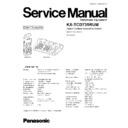Panasonic KX-TCD735RUM Service Manual ▷ View online
7.1.9.
KEYBOARD (SEE Fig. 26)
The keyboard “On” button is connected directly to pin 33 and 28 of the BBIC. When pressed it turns the handset on and off.
All other keys are connected in a row/column matrix. They are scanned in five rows using scan pulses (only active when keys
are pressed) from IC1 pins 15 to 19. The five key matrix columns are input to the BBIC on pins 51, 52, 53, 57 and 58.
All other keys are connected in a row/column matrix. They are scanned in five rows using scan pulses (only active when keys
are pressed) from IC1 pins 15 to 19. The five key matrix columns are input to the BBIC on pins 51, 52, 53, 57 and 58.
7.1.10. LCD DISPLAY, AND DISPLAY DRIVER (SEE Fig. 26)
The LCD display receives data via a serial interface. Serial data is sent to the display on pin 6 of the J5 socket, with control lines
at pin3 thru 6.
at pin3 thru 6.
Fig. 26
29
KX-TCD735RUM
7.1.11. BATTERY SUPPLY (SEE Fig. 27)
A switch mode boost converter is used to provide a 3.8V supply from the battery. This supply is sensed by the BBIC through
pin 26 (TP14) so that the switching rate can be controlled by a FET (T3) driven from pin 24 (TP13). A resistor on the Source
ofthe FET provides a current sense at pin 25 (TP12).
pin 26 (TP14) so that the switching rate can be controlled by a FET (T3) driven from pin 24 (TP13). A resistor on the Source
ofthe FET provides a current sense at pin 25 (TP12).
T3 switches the current through L1. When T3 switches off the back emf conducts through D16 and charges the reservoir cap
C4.
C4.
7.1.12. 2.65V REGULATOR (SEE Fig. 27)
A 2.65V supply is provided for the BBIC and is regulated by the BBIC’s on board control signal LRB (pin 37).
This reference is fed to the base of T6 to keep the “VREG+” line at 2.65V.
7.1.13. BATTERY CHARGING CIRCUIT (SEE Fig. 27)
The supply for the battery comes from the charge terminals at J3 and J4. Battery charge rate is controlled by switching the
current through T7 such that the average charging current is 170mA. The current flow is monitored at pin 49 of the BBIC by
measuring the voltage across R56.
current through T7 such that the average charging current is 170mA. The current flow is monitored at pin 49 of the BBIC by
measuring the voltage across R56.
D21 protects against the high voltage present on the charge contacts (J3 and J4) when there is no battery in the handset. R42
and C50 provide a signal to the BBIC (pin 27) to detect that the handset has been placed on the base charger.
and C50 provide a signal to the BBIC (pin 27) to detect that the handset has been placed on the base charger.
Fig. 27
30
KX-TCD735RUM
7.2.
RFSECTION
7.2.1.
BLOCK DIAGRAM RFSECTION (HANDSET)
Fig. 28
The RF section consists oftwo main components: The PMB6610 transceiver and the PMB6618 power amp.
In the transceiver the 10.368MHz clock signal SYCL is multiplied to around 1.9GHz using PLL (Phase Locked Loop) control.
The TXDA signal is used to control the modulation ofthis frequency to 1.87GHz to 1.93GHz.
The TXDA signal is used to control the modulation ofthis frequency to 1.87GHz to 1.93GHz.
Received signals are demodulated, filtered and sent to the BBIC via the RXDA line.
31
KX-TCD735RUM
8 CHECK PROCEDURE (BASE UNIT)
8.1.
EQUIPMENT REQUIRED
8.2.
INITIAL POWER TESTS
1. Turn on the 9V supply.
2. Check for approx. 90mA current on the 9V supply line.
3. Check the 3.8V supply rail at TP91. It must be 3.8V ± 0.2V.
4. Check the 2.7V supply rail at TP95. It must be 2.7V ± 0.2V.
5. Check the 6.0V supply rail at TP220. It must be 6.4V ± 0.3V.
32
KX-TCD735RUM
Click on the first or last page to see other KX-TCD735RUM service manuals if exist.

